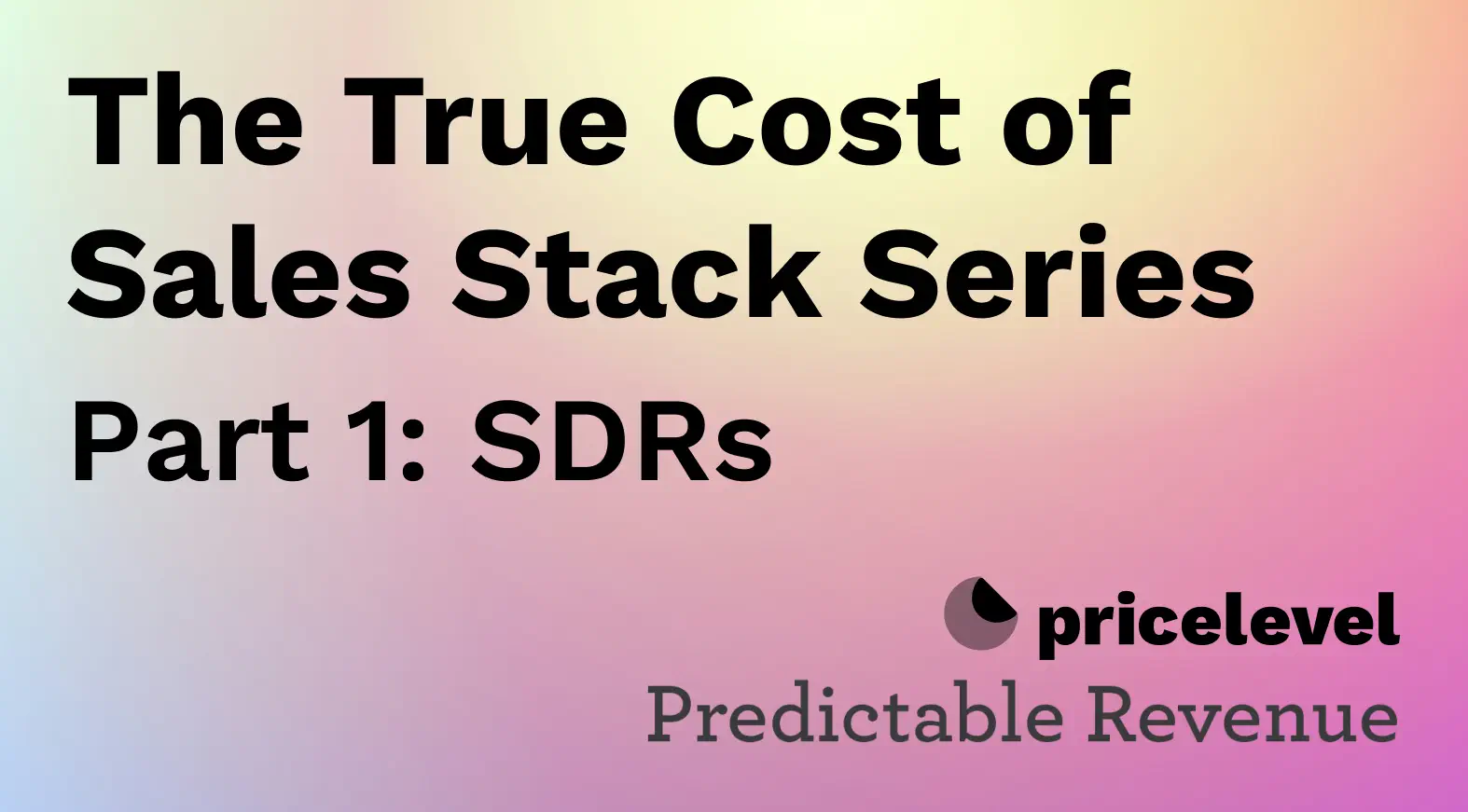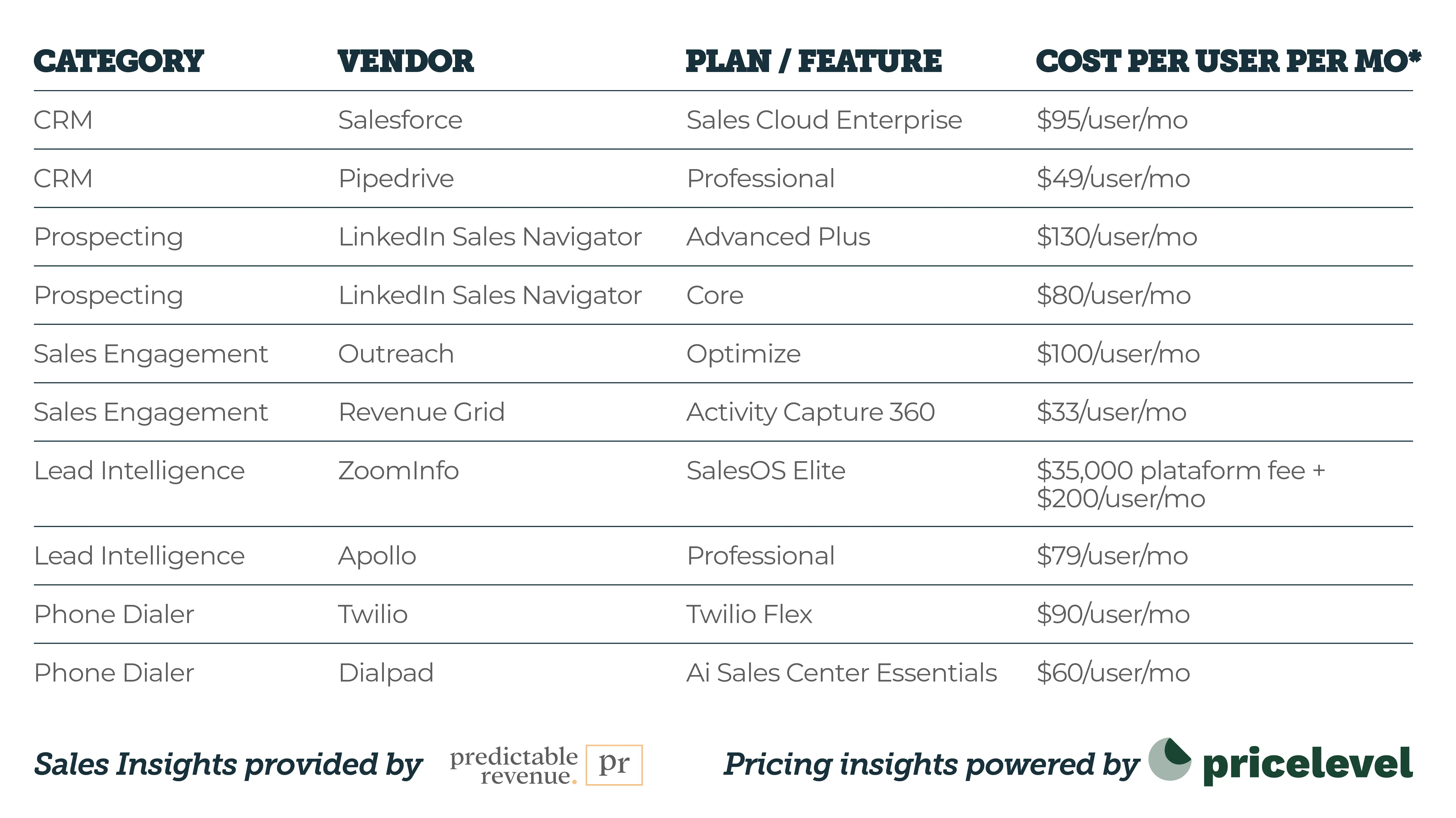The True Cost of SDR Tools and Software


In this series, we’ll explore the true cost of a deal by examining the tools and software cost associated with each role in the sales process. Predictable Revenue and PriceLevel have partnered to provide pricing transparency and a deeper understanding of the cost structures in the sales tech stack.
We kick off the series with Sales Development Representatives, better known as SDRs. In a nutshell, SDRs prospect, qualify leads, and collaborate with the wider sales team to drive revenue growth. This demanding role often uses more tools than the rest of the sales team due to the dynamic nature of their day to day making it all the more important to understand the true cost of the SDR tech stack. We’ve created fictional case studies below to highlight the differences in cost by company size.
Role and responsibilities of an SDR
SDRs play a crucial role within the sales ecosystem, specializing in lead generation and qualification. They are responsible for prospecting, identifying potential customers, and reaching out through outbound methods or responding to inbound requests. Their ultimate goal is to generate a steady pipeline of qualified leads for account executives.

To achieve that goal, an SDR organizes their day with activities revolving around generating and qualifying leads. They may spend any given hour identifying potential leads through targeted searches, reaching out via cold calls or messages, qualifying leads through questions, and collaborating with the sales team to ensure a smooth handoff. In addition to interacting with potential customers, SDRs are also in charge of updating the CRM with detailed notes for future interactions.
Performance tracking is vital given how many tasks the SDRs are responsible for. Typically, SDRs are goaled based on activity, quality, and/or conversion metrics. Examples include, but are not limited to:
- Number of calls or messages sent
- Number of meetings scheduled
- Number of qualified leads handed off
- Percentage of qualified leads or meetings scheduled from cold contacts
The primary aim of these goals is to motivate SDRs towards measurable outcomes in lead generation and qualification which in turn contributes to the company’s overall growth and revenue success.
The SDR tech stack
In order to achieve their goals, SDRs rely on a variety of tools to streamline their daily activities, automate tasks for productivity, and improve effectiveness in generating and qualifying leads. Nowadays, it’s common that the SDR tech stack includes:
- Customer Relationship Management (CRM) software - tools like Salesforce Sales Cloud, Hubspot Sales Hub or Pipedrive are essential for managing and organizing prospect data. SDRs use CRMs to track lead interactions, scheduled follow-up activities, and maintain detailed notes
- Prospecting tools - Linkedin Sales Navigator is still the go-to tool for finding and researching potential leads with their contact information and company details
- Sales engagement platforms - Outreach, Salesloft, and Revenue Grid are examples of platforms that help SDRs automate outreach campaigns. SDRs can personalize email templates, create email sequences, and track their performance
- Lead intelligence and data enrichment tools - tools like ZoomInfo, LeadIQ, or Apollo provide additional insights to effectively qualify leads. Data enrichment capabilities include job titles, company size, org charts, and anything else that might help personalize outreach
- Phone dialers - dialing tools like Dialpad, Twilio Flex, and RingCentral enable SDRs to make calls more efficiently. These dialers often include click-to-dial, call recordings, and analytics to manage performance
This tech stack doesn’t come cheap, but most of these tools, and thereby the costs, are shared with the wider sales organization. Unfortunately it’s difficult to find public pricing for many of these tools in order to understand the true cost but PriceLevel has pricing comps and negotiated discounts that other buyers have actually gotten for their SDR tech stack.
Decoding the cost of SDR tools and software
To fully understand the true cost of the SDR tech stack, we’ll use fictional case studies to explore what it would cost for a 10-person sales team and a 100-person sales team. But first, let’s establish the cost for these SDR tools:

The true cost of the SDR tech stack: 10-person sales team
There are many simple, but powerful tools geared towards smaller sales teams. The benefit of a smaller team is that often the pricing is transparent and straightforward to calculate. For this example, we’ll build the SDR tech stack using smaller alternative tools:

At a 10-person sales team, the annual true cost of the SDR tech stack is $36,120.
The true cost of the SDR tech stack: 100-person sales team
Once the sales team grows, there are many established tools meant for enterprise sales processes. The benefit of a larger team is that vendors will give volume discounts thereby decreasing the unit cost. For this example, we’ll build the SDR tech stack using established enterprise tools:

At a 100-person sales team, the annual true cost of the SDR tech stack is $761,000.
Conclusion
The true cost of the SDR tech stack depends on the vendor and size of the sales team, but companies should thoroughly research the wide variety of options to find the best fit for the team’s needs and budget. Investing in the tech stack is vital to the success of the SDR team. The best tools give SDRs the best chance at success to generate a steady pipeline of qualified leads for the account executives. We’ll explore AEs next, and find out the true cost of their tools and software for closing deals.
